Partial Order Ranking of the Key Drivers of Grassland Conversion in the Urban–Grassland Interface: A Case Study of the Hohhot–Baotou–Ordos Region
Abstract
1. Introduction
2. Materials and Methods
2.1. Study Area
2.2. Framework
2.3. Data Sources and Processing
2.3.1. Land-Use and Land-Cover Change Data and Processing
2.3.2. Identifying Potential Drivers
2.4. Methodologies
2.4.1. Assessment of Grassland Conversion Processes Between 2000 and 2020
2.4.2. Partial Order Theory
- Reflexivity—a ≤ a, for all a ∈ X;
- Transitivity—if a ≤ b and b ≤ c, then a ≤ c, for all a, b, c ∈ X;
- Antisymmetry—if a ≤ b and b ≤ a, then a = b, for all a, b ∈ X.
2.4.3. Hasse Diagram Technique
2.4.4. Application of Partial Order Theory
3. Results
3.1. Spatial and Temporal Analysis of Grassland Conversion Between 2000 and 2020
3.2. Partial Order Ranking of Grassland Conversion out Drivers Between 2000 and 2020
3.2.1. Partial Order Ranking of Grassland Conversion out Drivers in the Period from 2000 to 2010
3.2.2. Partial Order Ranking of Grassland Conversion out Drivers in the Period from 2010 to 2020
3.3. Ranking of All Driver Groups for the Two Periods (2000–2010 and 2010–2020)
4. Discussion
4.1. The Intensity of Land-Use and Land-Cover Change and Grassland Conversion in Hohhot–Baotou–Ordos Has Increased Since 2000
4.2. The Effect of Urbanization on Grassland Conversion out from 2000 to 2020
4.3. The Effect of Weather Variables on Grassland Conversion out from 2000 to 2020
4.4. Regional Variability in Grassland Degradation Drivers
4.5. Methodological Strengths and Limitations of Partial Order Theory
5. Conclusions
- (1)
- Between 2000 and 2020, land use in the HBO region underwent significant changes. From 2000 to 2010, 6.9% of the study area experienced land-use changes, which were primarily concentrated around Hohhot and Baotou. In the period from 2010 to 2020, the proportion of land-use change increased to 11%, with a notable rise in the intensity of land-use change in the region.
- (2)
- The spatiotemporal dynamics of GCO showed significant regional differences. From 2000 to 2010, approximately 2.1% of the study area underwent GCO, mainly from grassland to cropland, bare areas, or impervious surfaces. During this period, 3.5% of the land experienced GCI, primarily from bare areas, cropland, or forest. From 2010 to 2020, the proportion of GCO increased, reflecting the intensifying impact of land-use change on the grassland ecosystem.
- (3)
- From 2000 to 2020, the primary driving factors for GCO in the HBO region were urbanization, climate change, economic development, and human activities. Urbanization was the most significant driver of large-scale GCO. Climate change, particularly drought, also played a significant role, along with economic development and human activities.
Supplementary Materials
Author Contributions
Funding
Institutional Review Board Statement
Informed Consent Statement
Data Availability Statement
Conflicts of Interest
Abbreviations
| HBO | Hohhot–Baotou–Ordos |
| GC | Grassland Conversion |
| GCI | Grassland Conversion In |
| GCO | Grassland Conversion Out |
| POT | Partial Order Theory |
| HDT | Hasse Diagram Technique |
| HH | Hohhot |
| WC | Wuchuan |
| TKT | Tuoketuo |
| TMZ | Tumd East |
| QSH | Qingshuihe |
| HL | Helinger |
| HJ | Hangjin; |
| DLT | Dalate |
| ZGE | Zhungeer |
| DS | Dongsheng |
| ETK | Etuoke |
| YJHL | Yijinhuoluo |
| WS | Wushen |
| ETKQ | Etuokeqian |
| TMY | Tumed Right |
| BT | Baotou |
| GY | Guyang |
| DMJ | Darhan–Muminggan Joint County |
References
- Zhang, X.; Lark, T.J.; Clark, C.M.; Yuan, Y.; LeDuc, S.D. Grassland-to-Cropland Conversion Increased Soil, Nutrient, and Carbon Losses in the US Midwest between 2008 and 2016. Environ. Res. Lett. 2021, 16, 054018. [Google Scholar] [CrossRef] [PubMed]
- Jaureguiberry, P.; Titeux, N.; Wiemers, M.; Bowler, D.E.; Coscieme, L.; Golden, A.S.; Guerra, C.A.; Jacob, U.; Takahashi, Y.; Settele, J.; et al. The Direct Drivers of Recent Global Anthropogenic Biodiversity Loss. Sci. Adv. 2022, 8, eabm9982. [Google Scholar] [CrossRef] [PubMed]
- Hu, J.; Wu, Y.; Wang, L.; Sun, P.; Zhao, F.; Jin, Z.; Wang, Y.; Qiu, L.; Lian, Y. Impacts of Land-Use Conversions on the Water Cycle in a Typical Watershed in the Southern Chinese Loess Plateau. J. Hydrol. 2021, 593, 125741. [Google Scholar] [CrossRef]
- Li, Y.; Li, Y.; Zhang, Q.; Xu, G.; Liang, G.; Kim, D.G.; Carmona, C.R.; Yang, M.; Xue, J.; Xiang, Y.; et al. Enhancing Soil Carbon and Nitrogen through Grassland Conversion from Degraded Croplands in China: Assessing Magnitudes and Identifying Key Drivers of Phosphorus Reduction. Soil Tillage Res. 2024, 236, 105943. [Google Scholar] [CrossRef]
- Liu, J.; Xu, X.; Shao, Q. Grassland Degradation in the “Three-River Headwaters” Region, Qinghai Province. J. Geogr. Sci. 2008, 18, 259–273. [Google Scholar] [CrossRef]
- Batunacun; Wieland, R.; Lakes, T.; Nendel, C. Using Shapley Additive Explanations to Interpret Extreme Gradient Boosting Predictions of Grassland Degradation in Xilingol, China. Geosci. Model. Dev. 2021, 14, 1493–1510. [Google Scholar] [CrossRef]
- Barnes, K.W.; Niemuth, N.D.; Iovanna, R. Landscape-scale Predictions of Future Grassland Conversion to Cropland or Development. Conserv. Biol. 2025, 39, e14346. [Google Scholar] [CrossRef]
- Liu, Y.; Liu, X.; Zhao, C.; Wang, H.; Zang, F. The Trade-Offs and Synergies of the Ecological-Production-Living Functions of Grassland in the Qilian Mountains by Ecological Priority. J. Environ. Manag. 2023, 327, 116883. [Google Scholar] [CrossRef]
- Batunacun; Wieland, R.; Lakes, T.; Yunfeng, H.; Nendel, C. Identifying Drivers of Land Degradation in Xilingol, China, between 1975 and 2015. Land Use Policy 2019, 83, 543–559. [Google Scholar] [CrossRef]
- Tian, Y.; Jiang, G.; Wu, S.; Zhou, D.; Zhou, T.; Tian, Y.; Chen, T. Cropland-Grassland Use Conversions in the Agro-Pastoral Areas of the Tibetan Plateau: Spatiotemporal Pattern and Driving Mechanisms. Ecol. Indic. 2023, 146, 109819. [Google Scholar] [CrossRef]
- Tang, S.; Li, S.; Wang, Z.; Zhang, Y.; Wang, K. Effects of Grassland Converted to Cropland on Soil Microbial Biomass and Community from Agro-pastoral Ecotone in Northern China. Grassl. Sci. 2022, 68, 36–43. [Google Scholar] [CrossRef]
- Zhang, X.; Deng, Y.; Hou, M.; Yao, S. Response of Land Use Change to the Grain for Green Program and Its Driving Forces in the Loess Hilly-Gully Region. Land 2021, 10, 194. [Google Scholar] [CrossRef]
- Ren, H.; Liu, Y.; Wen, Z.; Shi, H.; Zhou, R.; Wang, Z.; Kareem, H.A.; Zhang, W. Untangling the Effects of Climate Variation and Human Interference on Grassland Dynamics in North China. Land Degrad. Dev. 2024, 35, 467–483. [Google Scholar] [CrossRef]
- Batunacun. Scenario Analysis of Ecosystem Service Changes—A Case Study of Ordos. Ph.D. Thesis, Inner Mongolia Normal University, Hohhot, China, 2024.
- Bai, W.; Zhao, S. An Analysis on Driving Force System of Land Use Changes. Resour. Sci. 2001, 23, 39–41. [Google Scholar]
- Jacquin, A.; Goulard, M.; Hutchinson, J.M.S.; Devienne, T.; Hutchinson, S.L. A Statistical Approach for Predicting Grassland Degradation in Disturbance-Driven Landscapes. J. Environ. Prot. 2016, 7, 912–925. [Google Scholar] [CrossRef]
- Li, Y.; Liang, S.; Zhao, Y.; Li, W.; Wang, Y. Machine Learning for the Prediction of L. Chinensis Carbon, Nitrogen and Phosphorus Contents and Understanding of Mechanisms Underlying Grassland Degradation. J. Environ. Manag. 2017, 192, 116–123. [Google Scholar] [CrossRef]
- Tidmarsh, C.E.M.; Havenga, C.E. The Wheel-Point Method of Survey and Measurement of Semi-Open Grasslands and Karoo Vegetation in South Africa; CABI: São Paulo, Brazil, 1955. [Google Scholar]
- Korell, L.; Andrzejak, M.; Berger, S.; Durka, W.; Haider, S.; Hensen, I.; Herion, Y.; Höfner, J.; Kindermann, L.; Klotz, S.; et al. Land Use Modulates Resistance of Grasslands against Future Climate and Inter-annual Climate Variability in a Large Field Experiment. Glob. Change Biol. 2024, 30, e17418. [Google Scholar] [CrossRef]
- Parente, L.; Sloat, L.; Mesquita, V.; Consoli, D.; Stanimirova, R.; Hengl, T.; Bonannella, C.; Teles, N.; Wheeler, I.; Hunter, M.; et al. Annual 30-m Maps of Global Grassland Class and Extent (2000–2022) Based on Spatiotemporal Machine Learning. Sci. Data 2024, 11, 1303. [Google Scholar] [CrossRef]
- Yang, D.; Yang, Z.; Wen, Q.; Ma, L.; Guo, J.; Chen, A.; Zhang, M.; Xing, X.; Yuan, Y.; Lan, X.; et al. Dynamic Monitoring of Aboveground Biomass in Inner Mongolia Grasslands over the Past 23 Years Using GEE and Analysis of Its Driving Forces. J. Environ. Manag. 2024, 354, 120415. [Google Scholar] [CrossRef]
- Du, Q.; Sun, Y.; Guan, Q.; Pan, N.; Wang, Q.; Ma, Y.; Li, H.; Liang, L. Vulnerability of Grassland Ecosystems to Climate Change in the Qilian Mountains, Northwest China. J. Hydrol. 2022, 612, 128305. [Google Scholar] [CrossRef]
- Brüggemann, R.; Carlsen, L. Introduction to Partial Order Theory Exemplified by the Evaluation of Sampling Sites. In Partial Order in Environmental Sciences and Chemistry; Brüggemann, R., Carlsen, L., Eds.; Springer: Berlin/Heidelberg, Germany, 2006; pp. 61–110. ISBN 978-3-540-33968-7. [Google Scholar]
- Bruggemann, R.; Voigt, K. Antichains in Partial Order, Example: Pollution in a German Region by Lead, Cadmium, Zinc and Sulfur in the Herb Layer. Match Commun. Math. Comput. Chem. 2012, 67, 731–744. [Google Scholar]
- Ivaldi, E.; Ciacci, A.; Soliani, R. Urban Deprivation in Argentina: A POSET Analysis. Pap. Reg. Sci. 2020, 99, 1723–1748. [Google Scholar] [CrossRef]
- Simon, U.; Brüggemann, R.; Pudenz, S.; Behrendt, H. Aspects of Decision Support in Water Management: Data Based Evaluation Compared with Expectations. In Partial Order in Environmental Sciences and Chemistry; Brüggemann, R., Carlsen, L., Eds.; Springer: Berlin/Heidelberg, Germany, 2006; pp. 221–236. ISBN 978-3-540-33968-7. [Google Scholar]
- Su, R.; Yu, T.; Dayananda, B.; Bu, R.; Su, J.; Fan, Q. Impact of Climate Change on Primary Production of Inner Mongolian Grasslands. Glob. Ecol. Conserv. 2020, 22, e00928. [Google Scholar] [CrossRef]
- Liu, L.; Hu, X.; Li, L.; Zhang, Q. Grassland or Cropland? Land Use Dilemma and Ecological Solutions in Inner Mongolia. Land Degrad. Dev. 2024, 35, 5741–5753. [Google Scholar] [CrossRef]
- Dong, Z.; Zhang, J.; Si, A.; Tong, Z.; Na, L. Multidimensional Analysis of the Spatiotemporal Variations in Ecological, Production and Living Spaces of Inner Mongolia and an Identification of Driving Forces. Sustainability 2020, 12, 7964. [Google Scholar] [CrossRef]
- Li, T.; Zhang, Q.; Wang, G.; Singh, V.P.; Zhao, J.; Sun, S.; Wang, D.; Liu, T.; Duan, L. Ecological Degradation in the Inner Mongolia Reach of the Yellow River Basin, China: Spatiotemporal Patterns and Driving Factors. Ecol. Indic. 2023, 154, 110498. [Google Scholar] [CrossRef]
- Li, M.; Zhao, P.; Wu, L.; Chen, K. Effects of Value Perception, Environmental Regulation and Their Interaction on the Improvement of Herdsmen’s Grassland Ecological Policy Satisfaction. Int. J. Environ. Res. Public. Health 2021, 18, 3078. [Google Scholar] [CrossRef]
- Yang, W.; Xia, B.; Li, Y.; Qi, X.; Zhang, J. Prediction and Scenario Simulation of Carbon Emissions Peak of Resource-Based Urban Agglomeration with Industrial Clusters—Case of Hubaoe Urban Agglomeration Inner Mongolia Autonomous Region, China. Energies 2024, 17, 5521. [Google Scholar] [CrossRef]
- Sargai; Dong, Y.; Kuang, W.; Bao, Y.; Dou, Y.; Wang, J. Impact of Urbanization on Terrestrial Carbon Storage Loss in the Hohhot-Baotou-Ordos Region, China: Evaluating People-Space Interactions. Int. J. Digit. Earth 2024, 17, 2339365. [Google Scholar] [CrossRef]
- Feng, Y.; Zhang, W.; Yu, J.; Zhuo, R. Optimization of Land-Use Pattern Based on Suitability and Trade-Offs between Land Development and Protection: A Case Study of the Hohhot-Baotou-Ordos (HBO) Area in Inner Mongolia, China. J. Clean. Prod. 2024, 466, 142796. [Google Scholar] [CrossRef]
- Wang, Z.; Zhao, X. Study on Spatial and Temporal Characteristics of Construction Land Expansion in Hohhot City Center, 1992-2022. J. Big Data Comput. 2023, 1, 39–45. [Google Scholar] [CrossRef]
- Li, P.; He, C.; Huang, Q.; Wang, Y.; Duan, X. Metacoupling Flow of Embodied Carbon in Resource-Based Cities: A Case Study of Hohhot-Baotou-Ordos-Yulin Urban Agglomeration in China. Energy 2024, 313, 134041. [Google Scholar] [CrossRef]
- Woodworth, M.D. Ordos Municipality: A Market-Era Resource Boomtown. Cities 2015, 43, 115–132. [Google Scholar] [CrossRef]
- Zhang, X.; Zhao, T.; Xu, H.; Liu, W.; Wang, J.; Chen, X.; Liu, L. GLC_FCS30D: The First Global 30 m Land-Cover Dynamics Monitoring Product with a Fine Classification System for the Period from 1985 to 2022 Generated Using Dense-Time-Series Landsat Imagery and the Continuous Change-Detection Method. Earth Syst. Sci. Data 2024, 16, 1353–1381. [Google Scholar] [CrossRef]
- Liu, J.Y.; Liu, M.; Tian, H.; Zhuang, D.; Zhang, Z.; Zhang, W.; Tang, X.; Deng, X. Spatial and Temporal Patterns of China’s Cropland during 1990–2000: An Analysis Based on Landsat TM Data. Remote Sens. Environ. 2005, 98, 442–456. [Google Scholar] [CrossRef]
- Available online: https://www.britannica.com/science/biodiversity-loss (accessed on 3 January 2025).
- Zhai, Y.; Wang, Y.; Hao, L.; Qi, W. Medium- and Long-Term Independent Contributions of Climate Change, Management Measures and Land Conversion to Vegetation Dynamics and Inspiration for Ecological Restoration in Inner Mongolia, China. Ecol. Eng. 2025, 212, 107504. [Google Scholar] [CrossRef]
- Wu, J.; Sun, Z.; Yao, Y.; Liu, Y. Trends of Grassland Resilience under Climate Change and Human Activities on the Mongolian Plateau. Remote Sens. 2023, 15, 2984. [Google Scholar] [CrossRef]
- Bai, Y.; Deng, X.; Cheng, Y.; Hu, Y.; Zhang, L. Exploring Regional Land Use Dynamics under Shared Socioeconomic Pathways: A Case Study in Inner Mongolia, China. Technol. Forecast. Soc. 2021, 166, 120606. [Google Scholar] [CrossRef]
- Xiaoyu, Z.; Gang, D.; Xiaoping, X.; Changliang, S.; Dawei, X.; Ruirui, Y.; Lijun, X.; Jing, Z.; Chen, M.; Ming, L. Divergent Socioeconomic Drivers of Land Use at Various Times in the Hulunber Grassland Area, China. Ecol. Indic. 2021, 132, 108243. [Google Scholar] [CrossRef]
- Berdimbetov, T.; Ma, Z.-G.; Shelton, S.; Ilyas, S.; Nietullaeva, S. Identifying Land Degradation and Its Driving Factors in the Aral Sea Basin from 1982 to 2015. Front. Earth Sci. 2021, 9, 690000. [Google Scholar] [CrossRef]
- Gang, C.; Zhao, W.; Zhao, T.; Zhang, Y.; Gao, X.; Wen, Z. The Impacts of Land Conversion and Management Measures on the Grassland Net Primary Productivity over the Loess Plateau, Northern China. Sci. Total Environ. 2018, 645, 827–836. [Google Scholar] [CrossRef]
- Hu, Y.; Nacun, B. An Analysis of Land-Use Change and Grassland Degradation from a Policy Perspective in Inner Mongolia, China, 1990–2015. Sustainability 2018, 10, 4048. [Google Scholar] [CrossRef]
- Hilckmann, A.; Bach, V.; Bruggemann, R.; Ackermann, R.; Finkbeiner, M. Partial Order Analysis of the Government Dependence of the Sustainable Development Performance in Germany’s Federal States. In Partial Order Concepts in Applied Sciences; Fattore, M., Bruggemann, R., Eds.; Springer International Publishing: Cham, Switzerland, 2017; pp. 219–228. ISBN 978-3-319-45419-1. [Google Scholar]
- Brüggemann, R.; Patil, G.P. Ranking and Prioritization for Multi-Indicator Systems: Introduction to Partial Order Applications; Springer New York: New York, NY, USA, 2011; ISBN 978-1-4419-8476-0. [Google Scholar]
- Tsonkova, P.; Böhm, C.; Quinkenstein, A.; Freese, D. Application of Partial Order Ranking to Identify Enhancement Potentials for the Provision of Selected Ecosystem Services by Different Land Use Strategies. Agric. Syst. 2015, 135, 112–121. [Google Scholar] [CrossRef]
- Na, L.; Zhao, Y.; Guo, L. Coupling Coordination Analysis of Ecosystem Services and Urbanization in Inner Mongolia, China. Land 2022, 11, 1870. [Google Scholar] [CrossRef]
- Zhang, L.; Hu, Z.; Yang, D.; Li, H.; Liu, B.; Gao, H.; Cao, C.; Zhou, Y.; Li, J.; Li, S. Land Use Dynamic Evolution and Driving Factors of Typical Open-Pit Coal Mines in Inner Mongolia. Int. J. Environ. Res. Public. Health 2022, 19, 9723. [Google Scholar] [CrossRef]
- Jiao, J.; Li, S.; Wang, W.; Qi, L.; Degen, A.A.; Bai, Y.; Jiao, T.; Shang, Z. Land Parcellation Reduced Spatial Redundancy Resulting in Grassland Degradation. People Nat. 2024, 6, 2528–2542. [Google Scholar] [CrossRef]
- Long, H.; Tang, G.; Li, X.; Heilig, G.K. Socio-Economic Driving Forces of Land-Use Change in Kunshan, the Yangtze River Delta Economic Area of China. J. Environ. Manag. 2007, 83, 351–364. [Google Scholar] [CrossRef]
- Chen, J.; Liu, M.; Chen, X.; Li, Z. Spatio-Temporal Evolution, Driving Mechanisms, and Simulation of Land Use and Cover in China from 2000 to 2060. Appl. Spat. Anal. 2024, 17, 1631–1652. [Google Scholar] [CrossRef]
- Zou, L.; Liu, Y.; Wang, Y. Research Progress and Prospect of Land-Use Conflicts in China. Prog. Geogr. 2020, 39, 298–309. [Google Scholar] [CrossRef]
- Li, C.; Wu, J. Land Use Transformation and Eco-Environmental Effects Based on Production-Living-Ecological Spatial Synergy: Evidence from Shaanxi Province, China. Environ. Sci. Pollut. Res. 2022, 29, 41492–41504. [Google Scholar] [CrossRef]
- Cao, H.; Li, M.; Qin, F.; Xu, Y.; Zhang, L.; Zhang, Z. Economic Development, Fiscal Ecological Compensation, and Ecological Environment Quality. Int. J. Environ. Res. Public. Health 2022, 19, 4725. [Google Scholar] [CrossRef] [PubMed]
- Shi, H.; Li, Q.; Zhang, S.; Chen, W.; Wang, Y.; Shen, Y. Does Urban Construction Land in China Achieve Sustainable Allocation and Utilization? Land Use Policy 2024, 144, 107223. [Google Scholar] [CrossRef]
- Bardgett, R.D.; Bullock, J.M.; Lavorel, S.; Manning, P.; Schaffner, U.; Ostle, N.; Chomel, M.; Durigan, G.L.; Fry, E.; Johnson, D.; et al. Combatting Global Grassland Degradation. Nat. Rev. Earth Environ. 2021, 2, 720–735. [Google Scholar] [CrossRef]
- Liyan, W.; Yi, X.; Ling, J.; Enming, R.; Zhiyun, O.; Hua, Z. The Influence of Urbanization on Ecosystem Services in the Hohhot-Baotou-Ordos Region. Acta Ecol. Sin. 2016, 36, 6031–6039. [Google Scholar]
- Liu, S.; Li, W.; Qiao, W.; Wang, Q.; Hu, Y.; Wang, Z. Effect of Natural Conditions and Mining Activities on Vegetation Variations in Arid and Semiarid Mining Regions. Ecol. Indic. 2019, 103, 331–345. [Google Scholar] [CrossRef]
- Xing Long, X. A Study of the Coupling Relation between Mineral Resources Exploitation and Ecological Environment: Evidence from the Grassland of Inner Mongolia. IOP Conf. Ser. Earth Environ. Sci. 2021, 811, 012005. [Google Scholar] [CrossRef]
- Scanes, C.G. Chapter 19—Human Activity and Habitat Loss: Destruction, Fragmentation, and Degradation. In Animals and Human Society; Elsevier: Amsterdam, The Netherlands, 2018. [Google Scholar]
- Kou, J.; Gan, Y.; Lei, S.; Meng, W.; Feng, C.; Xiao, H. Soil Health and Ecological Risk Assessment in the Typical Coal Mines on the Mongolian Plateau. Ecol. Indic. 2022, 142, 109189. [Google Scholar] [CrossRef]
- Yang, F.; Wang, J.; Zhang, C.; Li, J.; Xie, H.; Zhuoge, Z. The Impact of Human Activities on Net Primary Productivity in a Grassland Open-Pit Mine: The Case Study of the Shengli Mining Area in Inner Mongolia, China. Land 2022, 11, 743. [Google Scholar] [CrossRef]
- Tang, L.; Ke, X.; Chen, Y.; Wang, L.; Zhou, Q.; Zheng, W.; Xiao, B. Which Impacts More Seriously on Natural Habitat Loss and Degradation? Cropland Expansion or Urban Expansion? Land Degrad. Dev. 2021, 32, 946–964. [Google Scholar] [CrossRef]
- Fang, Y.; Meng, F.; Luo, M.; Sa, C.; Lei, J.; Bao, Y.; Chao, L. Disentangling the Natural and Anthropogenic Contributions to the Balance of Ecosystem Services in the Beijing-Tianjin-Hebei-Inner Mongolia Region. Ecol. Indic. 2024, 158, 111372. [Google Scholar] [CrossRef]
- Wang, Z.; Deng, X.; Song, W.; Li, Z.; Chen, J. What Is the Main Cause of Grassland Degradation? A Case Study of Grassland Ecosystem Service in the Middle-South Inner Mongolia. Catena 2017, 150, 100–107. [Google Scholar] [CrossRef]
- Liu, S.; Li, T.; Liu, B.; Xu, C.; Zhu, Y.; Xiao, L. Grassland Vegetation Decline Is Exacerbated by Drought and Can Be Mitigated by Soil Improvement in Inner Mongolia, China. Sci. Total Environ. 2024, 908, 168464. [Google Scholar] [CrossRef]
- Zhang, H.; Liao, Z.; Yao, J.; Wang, T.; Xu, J.; Yan, B.; Liu, J. Response of Reduced Grassland Degradation Index to Climate Change in China. Agronomy 2024, 14, 1554. [Google Scholar] [CrossRef]
- Guo, X.; Arshad, M.U.; Zhao, Y.; Gong, Y.; Li, H. Effects of Climate Change and Grazing Intensity on Grassland Productivity—A Case Study of Inner Mongolia, China. Heliyon 2023, 9, e17814. [Google Scholar] [CrossRef]
- Zhang, M.; Sun, J.; Wang, Y.; Li, Y.; Duo, J. State-of-the-Art and Challenges in Global Grassland Degradation Studies. Geogr. Sustain. 2025, 6, 100229. [Google Scholar] [CrossRef]
- Alaimo, L.S.; Arcagni, A.; Fattore, M.; Maggino, F. Synthesis of Multi-Indicator System Over Time: A Poset-Based Approach. Soc. Indic. Res. 2021, 157, 77–99. [Google Scholar] [CrossRef]
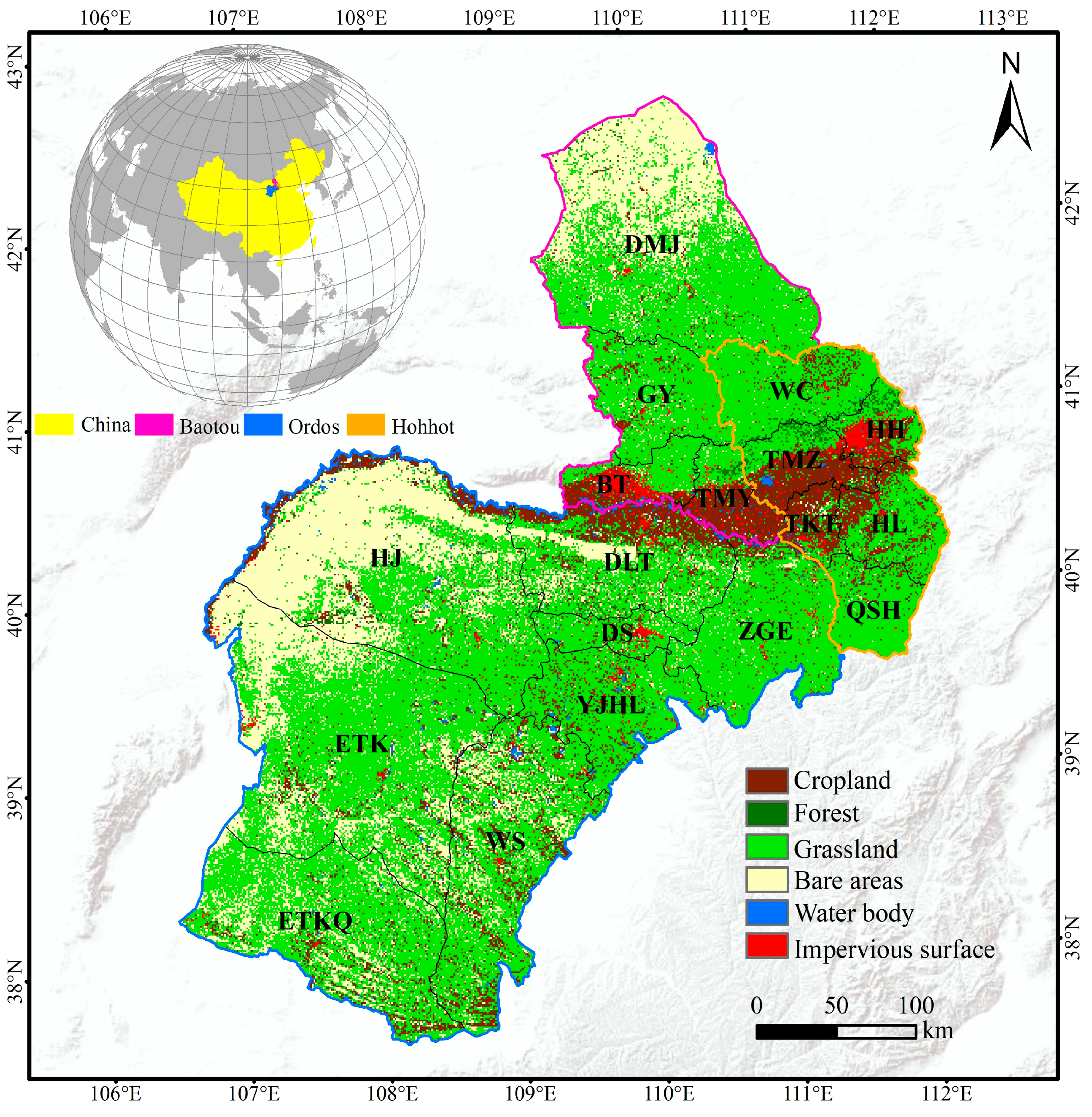
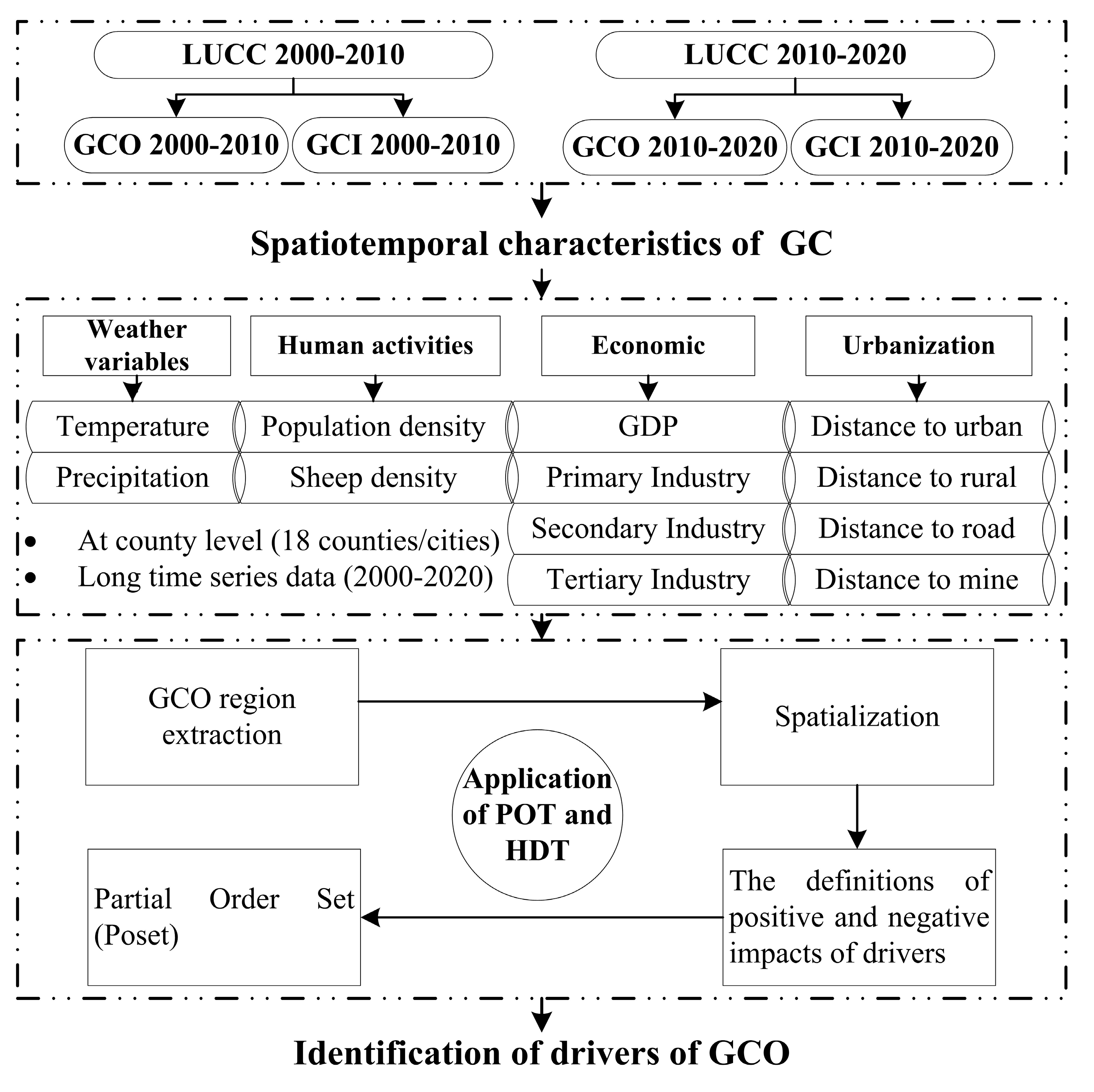


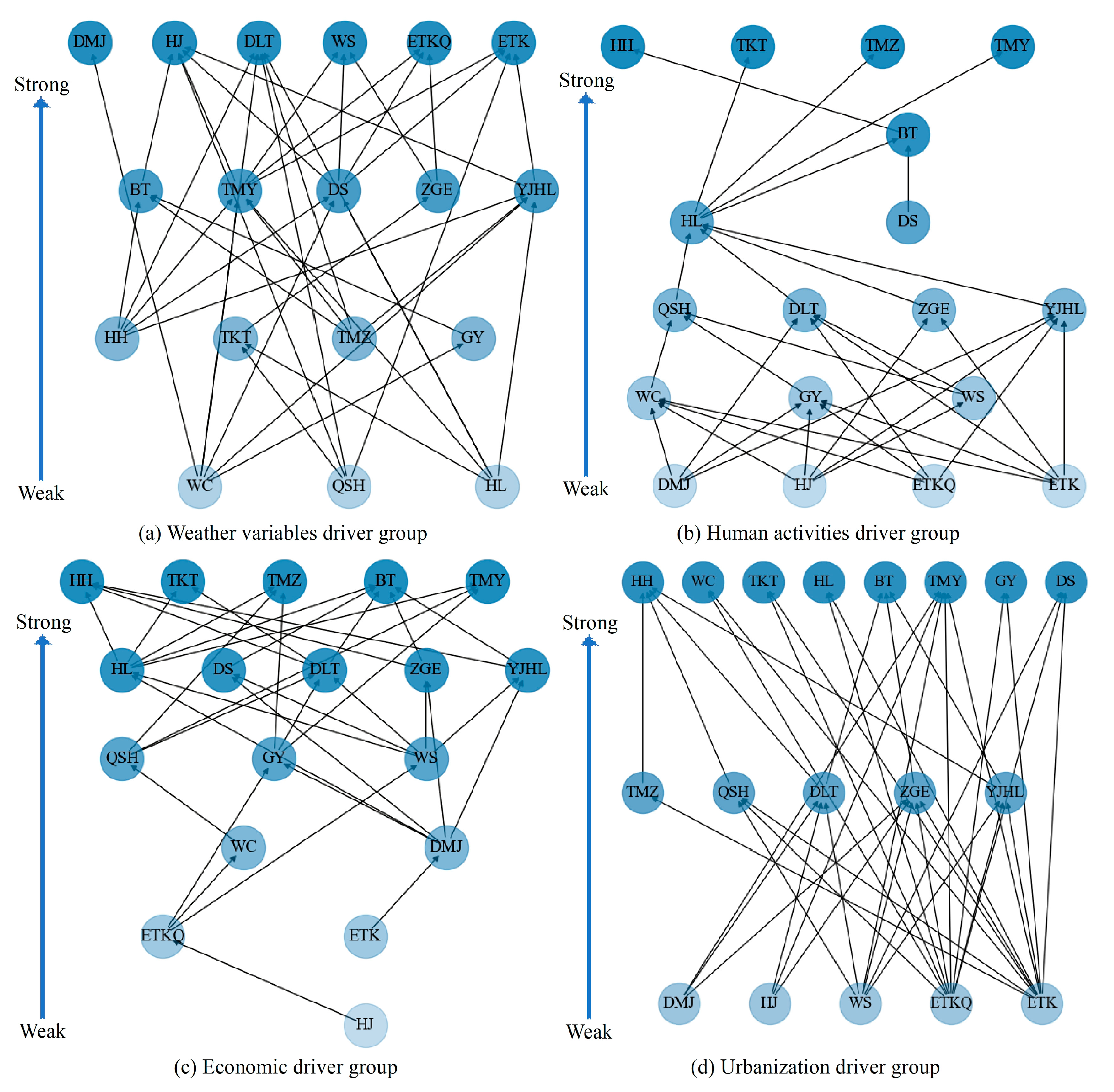
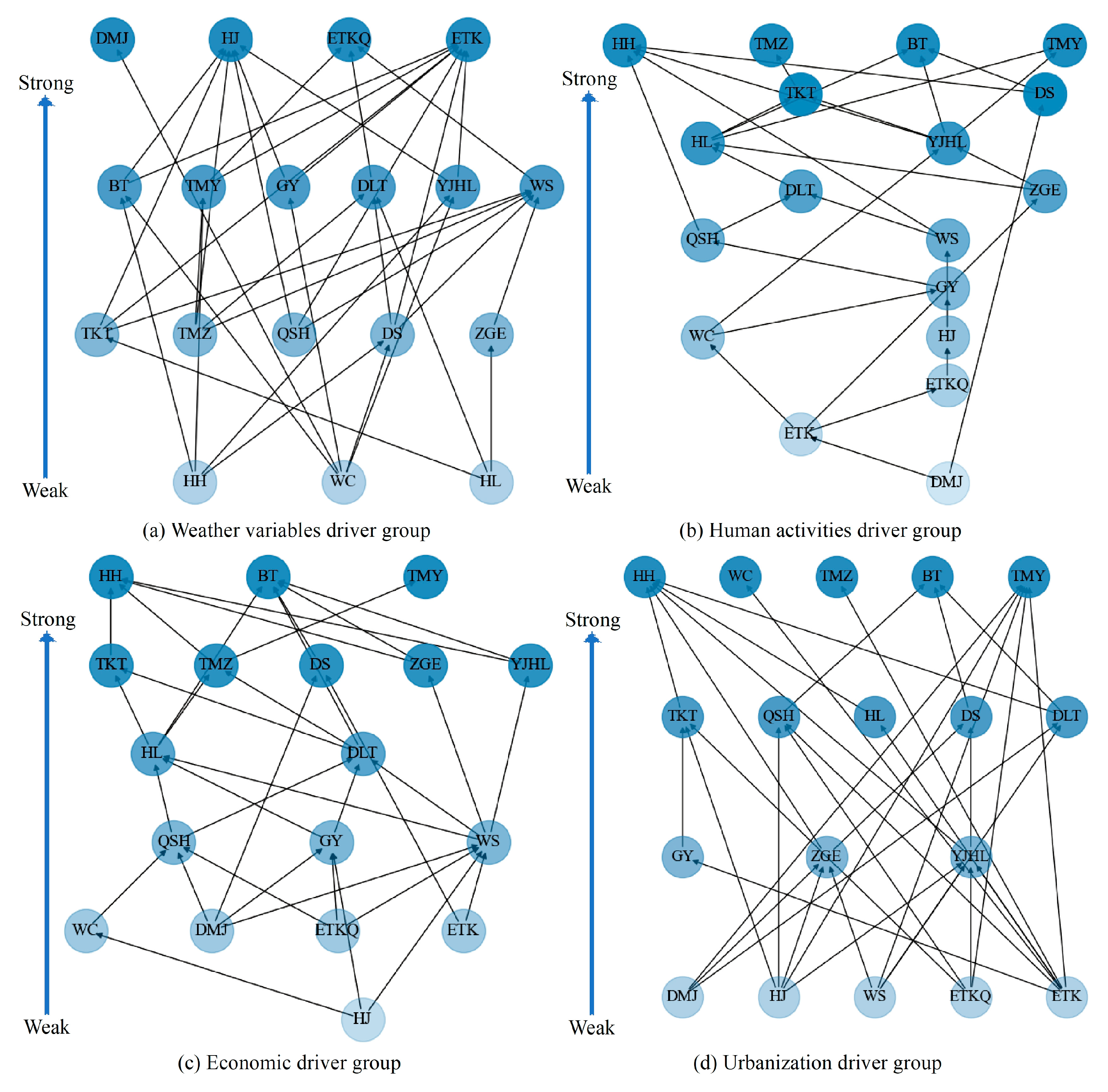
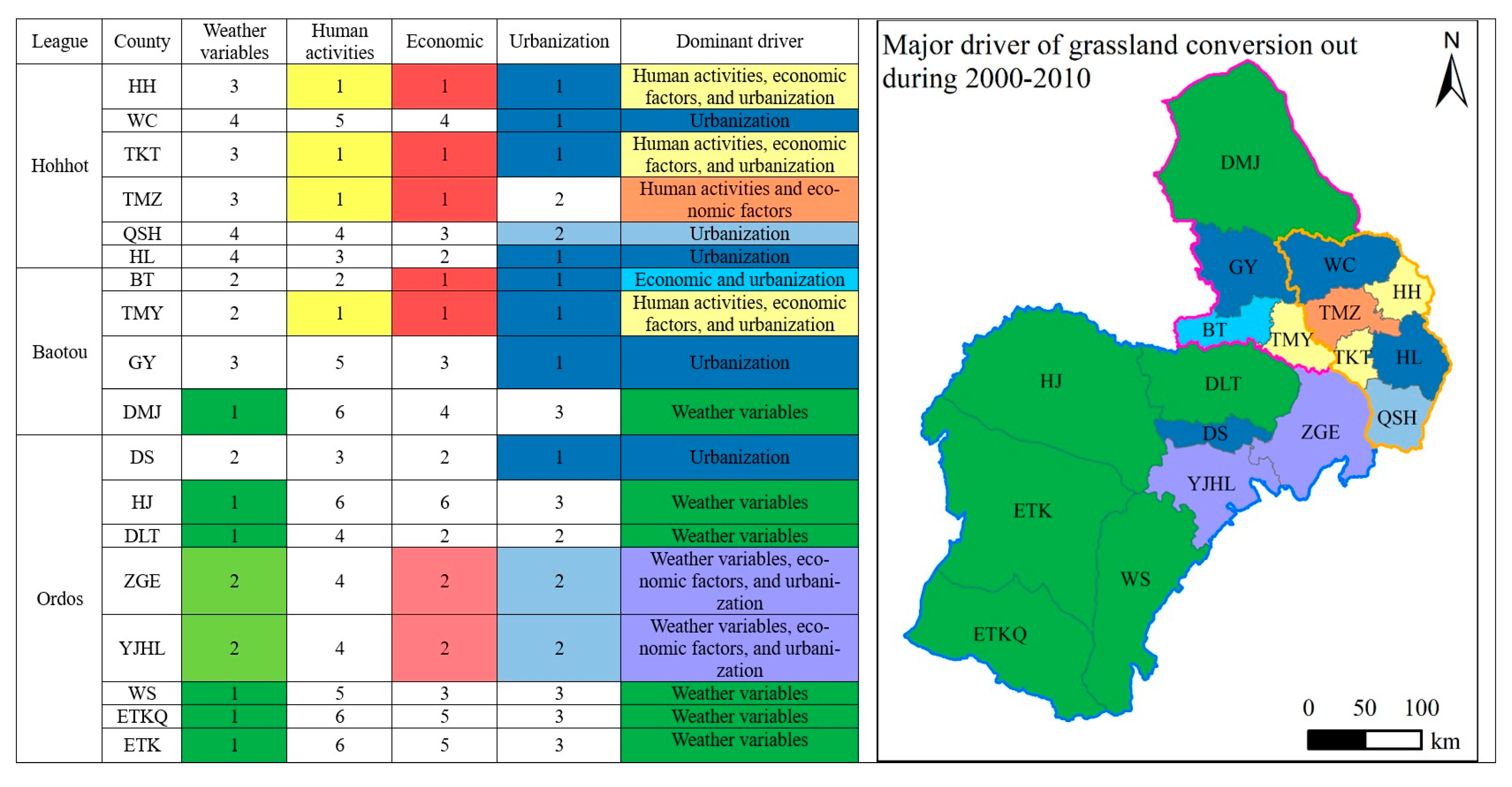
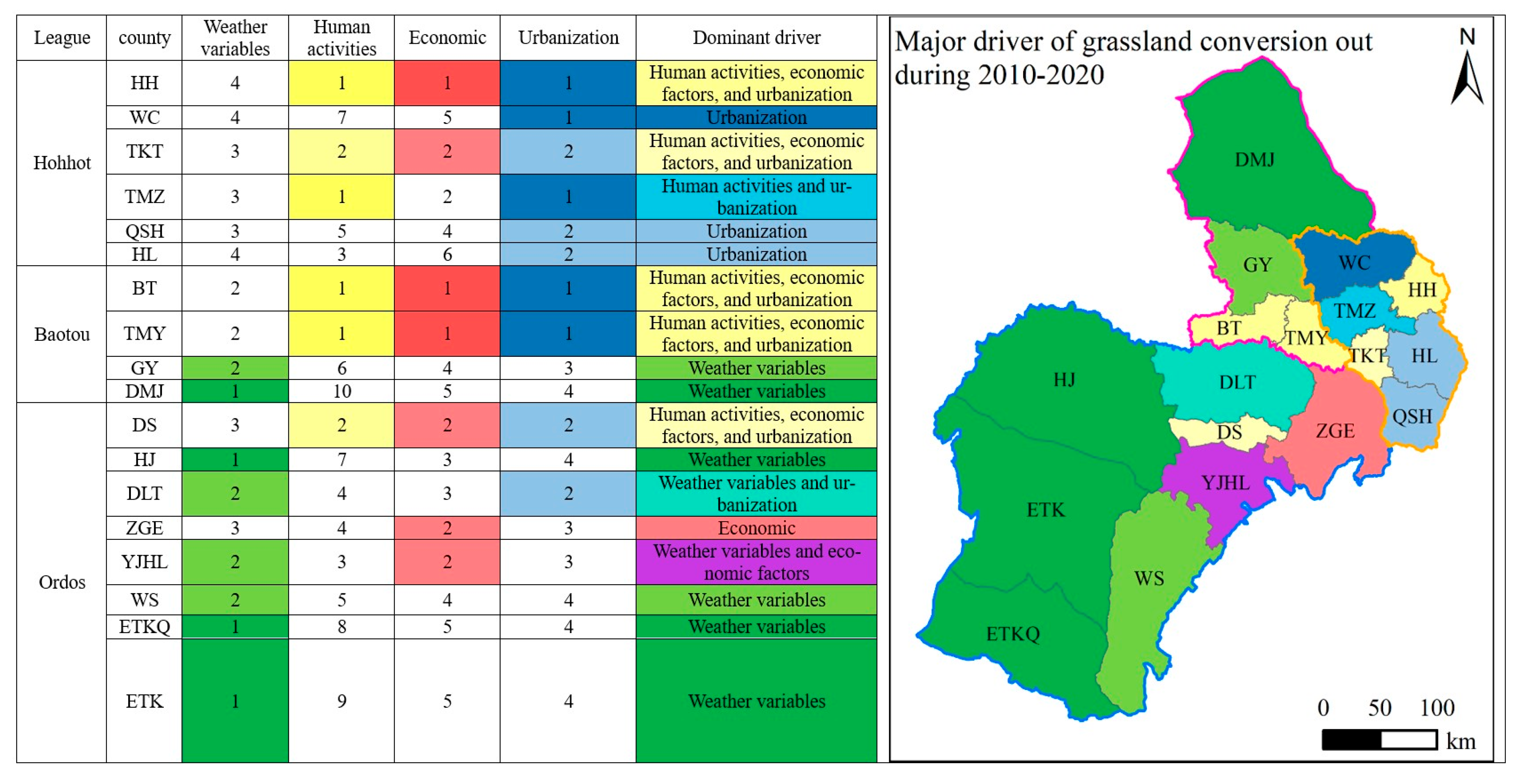
| Basic Classification System | Level 1 Validation System | Fine Classification System | ID | Description | Merged Category |
|---|---|---|---|---|---|
| Cropland | Rainfed cropland | Rainfed cropland | 10 | Land on which crops are grown | Cropland |
| Herbaceous cover cropland | 11 | ||||
| Irrigated cropland | Irrigated cropland | 20 | |||
| Forest | Deciduous broadleaved forest | Open deciduous broadleaved forest | 62 | Refers to the growth of trees, shrubs, bamboo, coastal mangrove forests and other forestry land | Forest |
| Evergreen needle-leaved forest | Closed evergreen needle-leaved forest | 71 | |||
| Open evergreen needle-leaved forest | 72 | ||||
| Deciduous needle-leaved forest | Open deciduous needle-leaved forest | 82 | |||
| Shrubland | Shrubland | Shrubland | 120 | ||
| Grassland | Grassland | Grassland | 130 | Refers to all kinds of grassland, mainly growing herbaceous plants and covering more than 5%, including shrubland grassland, mainly grazing and sparsely forested grassland with a canopy of less than 10% | Grassland |
| Bare areas | Sparse vegetation | Sparse vegetation | 150 | Land that has not yet been used, including land that is difficult to use | |
| Bare areas | Bare areas | 200 | Bare areas | ||
| Unconsolidated bare areas | 202 | ||||
| Wetland | Inland wetland | Marsh | 182 | Refers to natural land waters and water conservancy facilities | Waterbody |
| Flooded flat | 183 | ||||
| Waterbody | Waterbody | Waterbody | 210 | ||
| Impervious surface | Impervious surface | Impervious surface | 190 | Refers to urban and rural residential areas and other industrial, mining, transportation, and other land | Impervious surface |
| Groups of Driving Factors | Data Name | Unit | Year | Data Source | Orientation |
|---|---|---|---|---|---|
| Weather Variable-Related Driving Factors | Temperature | °C | 2000, 2010, 2020 | https://cds.climate.copernicus.eu/, accessed on 23 October 2024 | The greater the value, the greater the impact on land degradation |
| Precipitation | mm | 2000, 2010, 2020 | The greater the value, the smaller the impact on land degradation. Use 1—the corresponding value | ||
| Human Activity-Related Driving Factors | Population Density | Person/km2 | 2000, 2010, 2020 | http://www.resdc.cn/, accessed on 10 November 2024 | The greater the value, the greater the impact on land degradation |
| Livestock Density | Sheep unit/km2 | 2000, 2010, 2016 | Inner Mongolia Statistical Yearbook http://tj.nmg.gov.cn/, accessed on 15 November 2024 | ||
| Economic Development-Related Driving Factors | Primary Industry GDP Density | CNY 104/km2 | 2000, 2010, 2020 | ||
| Secondary Industry GDP Density | CNY 104/km2 | 2000, 2010, 2020 | |||
| Tertiary Industry GDP Density | CNY 104/km2 | 2000, 2010, 2020 | |||
| GDP Density | CNY 104/km2 | 2000, 2010, 2020 | |||
| Urbanization-Related Driving Factors | Distance to Urban Land | m | 2000, 2010, 2020 | http://www.resdc.cn/, accessed on 20 November 2024 | The greater the value, the smaller the impact on land degradation. Use 1—the corresponding value |
| Distance to Rural Settlements | m | 2000, 2010, 2020 | |||
| Distance to Roads | m | 2000, 2010, 2020 | |||
| Distance to Industrial and Mining Land | m | 2000, 2010, 2020 |
Disclaimer/Publisher’s Note: The statements, opinions and data contained in all publications are solely those of the individual author(s) and contributor(s) and not of MDPI and/or the editor(s). MDPI and/or the editor(s) disclaim responsibility for any injury to people or property resulting from any ideas, methods, instructions or products referred to in the content. |
© 2025 by the authors. Licensee MDPI, Basel, Switzerland. This article is an open access article distributed under the terms and conditions of the Creative Commons Attribution (CC BY) license (https://creativecommons.org/licenses/by/4.0/).
Share and Cite
Li, X.; An, C.; Batunacun; Feng, Y.; Liu, K.; Mei, Y. Partial Order Ranking of the Key Drivers of Grassland Conversion in the Urban–Grassland Interface: A Case Study of the Hohhot–Baotou–Ordos Region. Appl. Sci. 2025, 15, 5906. https://doi.org/10.3390/app15115906
Li X, An C, Batunacun, Feng Y, Liu K, Mei Y. Partial Order Ranking of the Key Drivers of Grassland Conversion in the Urban–Grassland Interface: A Case Study of the Hohhot–Baotou–Ordos Region. Applied Sciences. 2025; 15(11):5906. https://doi.org/10.3390/app15115906
Chicago/Turabian StyleLi, Xuemei, Chang An, Batunacun, Yu Feng, Kaixin Liu, and Yong Mei. 2025. "Partial Order Ranking of the Key Drivers of Grassland Conversion in the Urban–Grassland Interface: A Case Study of the Hohhot–Baotou–Ordos Region" Applied Sciences 15, no. 11: 5906. https://doi.org/10.3390/app15115906
APA StyleLi, X., An, C., Batunacun, Feng, Y., Liu, K., & Mei, Y. (2025). Partial Order Ranking of the Key Drivers of Grassland Conversion in the Urban–Grassland Interface: A Case Study of the Hohhot–Baotou–Ordos Region. Applied Sciences, 15(11), 5906. https://doi.org/10.3390/app15115906





